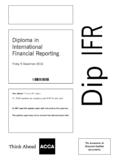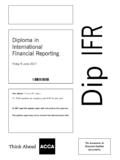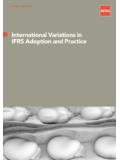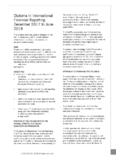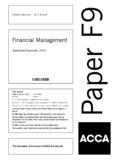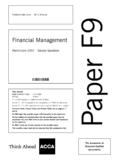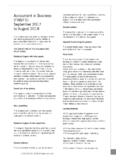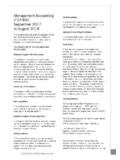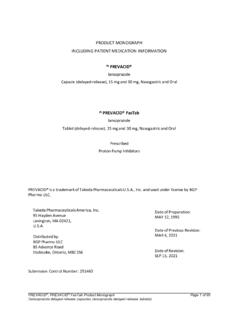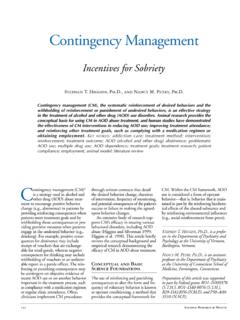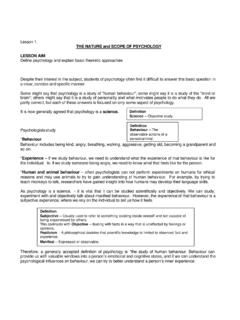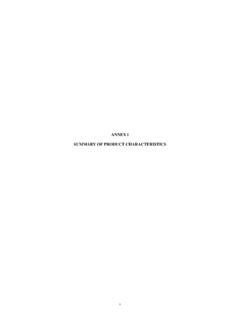Transcription of Answers - Association of Chartered Certified Accountants
1 AnswersProfessional Level Options Module, Paper P7 (UK)Advanced Audit and Assurance (United Kingdom)June 2009 Answers1(a)Briefing notesTo: Audit JuniorsFrom: Audit managerSubject: Understanding a client s business and environment(i)IntroductionGaining an understanding of the business of a client, and the environment in which it operates is a crucial part of theaudit planning process. ISA 315 (UK and Ireland) Obtaining an understanding of the entity and its environment andassessing the risks of material misstatementprovides guidance on this matter. The issue is that the auditor must havea thorough understanding of many aspects of the client s business and environment in order to be able to assess risk,decide on an appropriate audit strategy, and be able to design and perform effective audit to be consideredISA 315 states that there are five main aspects of the client s business and environment which the auditor , regulatory and other external factors, including the applicable financial reporting frameworkThis means having an understanding of the industry in which the company operates, including the level ofcompetition.
2 The nature of the relationships with suppliers and customers, and the level of technology used in theindustry. The industry may have specific laws and regulations which impact on the business. The auditor shouldalso consider wider economic factors such as the level and volatility of interest rates and exchange rates and theirpotential impact on the importance of these issues is their potential impact on the financial statements and on the planning of theaudit. For example, if a client operates in a highly regulated industry, it may be worth considering the inclusion inthe audit team of a person with specific experience or knowledge of those regulations.
3 Regulations include thefinancial reporting framework, for example, whether the company uses local or international financial of the entity and its accounting policiesThis includes having an understanding of the legal structure of the company (and group where relevant), theownership and governance structure, and the main sources of finance used by the company. Complex ownershipstructures with multiple subsidiaries and/or locations may increase the risk of material the nature of the company also includes an understanding of the accounting policies selected andapplied to the financial statements.
4 The auditor must consider whether the accounting policies applied areconsistent with the applicable financial reporting and strategies and related business risksThe management of the company should define the objectives of the business, which are the overall plans for thecompany. Strategies are the operational approaches by which management intend to meet the defined example, an objective could be to maximise market share, and the strategy to achieve this could be to launcha new brand or product every year. Business risks are factors which could stop the company achieving its statedobjectives, for example, launching a product for which there is limited demand.
5 Most business risks will eventuallyhave financial consequences, and thus an effect on the financial statements. This is why auditors perform abusiness risk assessment as part of their planning and review of the entity s financial performanceHere the auditor is looking to gain an understanding of the performance measures which management and othersconsider to be of importance. Performance measures can create pressure on management to take action to improvethe financial statements through deliberate misstatement. For example, a bonus payable to the management basedon revenue growth could create pressure for revenue to be overstated.
6 Thus the auditor must gain an understandingof the company s financial and non-financial key performance indicators, targets, budgets and controlThe auditor must gain knowledge of internal control in order to consider how different aspects of internal controlcould impact on the audit. Internal control includes the control environment, the entity s risk assessmentprocedures, information systems, control activities, and the monitoring of controls. Put simply, the evaluation of thestrength or weakness of internal control is a crucial consideration in the assessment of audit risk, and so will havea significant impact on the audit strategy.
7 The design and implementation of controls should be considered as partof gaining an understanding. The auditor should also understand whether controls are manual or automated. ISA315 contains a great deal of detailed guidance on the understanding of controls, which these briefing notes do (ii)Procedures used to gain of management and others within the companyA discussion with management is often the starting point in gaining understanding. A meeting is usually held withmanagement to talk about all of the aspects of the company and its environment referred to in the first part of thebriefing notes. However, inquiries can also be made of others, who may be able to provide a different perspectiveor provide specific insights into certain matters.
8 For example, internal auditors would be able to commentspecifically on internal Analytical proceduresAuditors perform analytical procedures at the planning stage in order to identify unusual transactions or events,and to understand the main trends reflected in the financial statements for the year. This will enable the auditor,for example, to see if the company has experienced a growth or decline in turnover or profits in the year, whichwhen reviewed in the context of industry or economic trends, may indicate a risk of material procedures should be performed in accordance with ISA 520 (UK and Ireland) Analytical may help to support inquiries of management and others, and could involve, for example, physicalobservation of the internal control operations, and visits to premises such as factories, warehouses and head may support inquiries made of management and others.
9 It could include, for example, an inspection ofbusiness plans, internal control manuals, reports made by management such as interim financial statements, theminutes of board meetings, and reviewing the company s website and must make sure that they have gained and documented an understanding of five main aspects of the client sbusiness and the environment in which it operates, and a variety of procedures can be used. Without a thoroughknowledge of the business and its environment, an auditor would be unable to effectively assess the risk of materialmisstatement in the financial statements, and therefore could not plan the audit to minimise audit risk.
10 (b)Business risks include the following:Health and safety regulationsChampers Ltd operates in a highly regulated industry, and the risk of non-compliance with various laws and regulations ishigh. The industry has strict health and safety regulations which must be complied with, and there will be regular health andsafety inspections to ensure that regulations are being adhered to. One of the Happy Monkeys restaurants failed a health andsafety inspection during the year. This could lead to bad publicity and damage to the brand name. As the Happy Monkeysbusiness segment contributes the highest proportion of revenue to the company, damage to this brand name could besignificant for the company.

